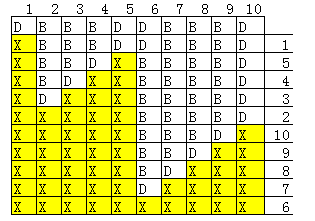Description
Andréh and his friend Andréas are board-game aficionados. They know many of their friends would love to go on a trip to Phuket, Thailand, and so they want to challenge them at Kem Kradãn, a traditional Thai board game.
Kem Kradãn (เกมกระดาน) has been played since the 2nd century AD. The game is played with N pieces where each piece has two faces, one of which is golden and the other is white. The game starts with all pieces arranged in a line on the board and they are numbered from 1 to N from left to right. When a piece numbered i has its golden face up, it can be removed from the board. When this is done, the pieces numbered i - 1 and i + 1 are flipped, if they're still there. The goal is to remove all game pieces.
Before challenging their friends, Andréh and Andréas want to make sure their initial configurations have a solution. To help them, given an initial configuration, you must determine if it is possible to remove all game pieces and, if so, you must show how to do it.
Input
The first line has a single integer T, the number of test cases.
Each test case is formed by a line containing an integer N, the number of pieces, followed by line containing a string of length Ncontaining only the letters B (white face up) and D (golden face up), representing the initial state of the game.
Limits
- 1 ≤ T ≤ 100
- 1 ≤ N ≤ 105
- The sum of N over all test cases will not exceed 5·105
Output
For each test case, print a line containing Y if it is possible to remove every piece from the board, or N otherwise. In case it is possible to remove all the pieces, you should also print on the next line a sequence of N integers each representing a piece number, indicating the order in which the pieces must be removed. If there is more than one possible sequence, you can print any of them.
Sample Input
4
3
BDB
5
DBDDB
5
DDBDD
6
DBBBBB
Y
2 3 1
Y
4 5 1 2 3
N
Y
1 2 3 4 5 6
/*/ 题意: 在一段字符里面有两种字符D和B,字符串中D可以直接拿掉,但是D两边的都要进行反转,B->D , D->B ,问能不能把所有的字符全部拿掉。 如果可以输出Y并且打印拿的过程。 如果不能就输出N。
暴力扫描,如果找到一个D那么从D开始往前面去拿掉字符串,如果前面的不能被拿掉,那么肯定这个字符串是不能被拿掉的。
举个栗子:
AC代码: /*/
#include"algorithm"
#include"iostream"
#include"cstring"
#include"cstdio"
using namespace std;
int main() {
int T,n;
int ans[111111],light[111111];
char s[111111];
cin>>T;
while(T--) {
memset(s,0,sizeof(s));
memset(ans,0,sizeof(ans));
memset(light,0,sizeof(light));
cin>>n;
scanf("%s",s+1);
for(int i=1; i<=n; i++) {
if(s[i]=='B')light[i]=2;
else light[i]=1;
}
int j;
int erear=0;
for(int i=1; i<=n; i++) {
j=i;
while(light[j]==1) {
if(j<=0)break;
if(j> n)break;
light[j]=0;
ans[erear++]=j;
if(light[j-1]==2)light[j-1]=1;
else if(light[j-1]==1)light[j-1]=2;
if(light[j+1]==2)light[j+1]=1;
else if(light[j+1]==1)light[j+1]=2;
j--;
}
}
int t=1;
if(erear==n) {
puts("Y");
for(int i=0; i<erear; i++) {
if(t)t=0;
else printf(" ");
printf("%d",ans[i]);
}
puts("");
} else puts("N");
}
return 0;
}
